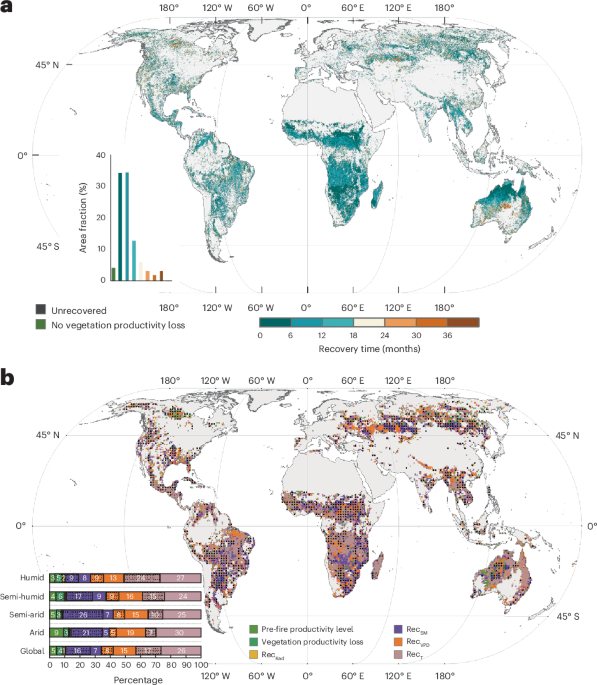
- Select a language for the TTS:
- UK English Female
- UK English Male
- US English Female
- US English Male
- Australian Female
- Australian Male
- Language selected: (auto detect) - EN
Play all audios:
A global analysis of post-fire vegetation productivity recovery reveals that the recovery time shows spatial variations across vegetation types and regions. The dominant factors that
influence the recovery time in the majority of the global burned area are the post-fire climate conditions, such as soil moisture, vapour pressure deficit and air temperature. Access through
your institution Buy or subscribe This is a preview of subscription content, access via your institution ACCESS OPTIONS Access through your institution Access Nature and 54 other Nature
Portfolio journals Get Nature+, our best-value online-access subscription $32.99 / 30 days cancel any time Learn more Subscribe to this journal Receive 12 print issues and online access
$259.00 per year only $21.58 per issue Learn more Buy this article * Purchase on SpringerLink * Instant access to full article PDF Buy now Prices may be subject to local taxes which are
calculated during checkout ADDITIONAL ACCESS OPTIONS: * Log in * Learn about institutional subscriptions * Read our FAQs * Contact customer support REFERENCES * Tangney, R. et al. Success of
post-fire plant recovery strategies varies with shifting fire seasonality. _Commun. Earth Environ._ 3, 126 (2022). THIS PAPER REPORTS HOW POST-FIRE PLANT RECRUITMENT, REPRODUCTION AND
SURVIVAL ARE AFFECTED BY FIRES THAT OCCUR OUTSIDE OF THE HISTORICAL FIRE SEASON. Article Google Scholar * Yue, X. & Unger, N. Fire air pollution reduces global terrestrial
productivity. _Nat. Commun._ 9, 5413 (2018). THIS PAPER EXPLORES THE NET IMPACTS OF FIRE-INDUCED OZONE DAMAGE AND THE DIFFUSE FERTILIZATION EFFECT OF AEROSOLS ON GPP. Article CAS Google
Scholar * Li, F., Bond-Lamberty, B. & Levis, S. Quantifying the role of fire in the Earth system – part 2: impact on the net carbon balance of global terrestrial ecosystems for the 20th
century. _Biogeosciences_ 11, 1345–1360 (2014). THIS PAPER PROVIDES A QUANTITATIVE ASSESSMENT OF THE IMPACT OF FIRE ON THE NET CARBON BALANCE OF GLOBAL TERRESTRIAL ECOSYSTEMS AND EXAMINES
THE ROLES OF THE DIRECT AND INDIRECT EFFECTS OF FIRE. Article Google Scholar * Bousquet, E., Mialon, A., Rodriguez-Fernandez, N., Mermoz, S. & Kerr, Y. Monitoring post-fire recovery of
various vegetation biomes using multi-wavelength satellite remote sensing. _Biogeosciences_ 19, 3317–3336 (2022). THIS PAPER PROVIDES A QUANTITATIVE ASSESSMENT OF THE POST-FIRE RECOVERY OF
VARIOUS VEGETATION BIOMES USING MULTIPLE VEGETATION INDICES DERIVED FROM VARIOUS SENSORS. Article Google Scholar Download references ADDITIONAL INFORMATION PUBLISHER’S NOTE Springer Nature
remains neutral with regard to jurisdictional claims in published maps and institutional affiliations. THIS IS A SUMMARY OF: Xu, H. et al. Global patterns and drivers of post-fire
vegetation productivity recovery. _Nat. Geosci_. https://doi.org/10.1038/s41561-024-01520-3 (2024). RIGHTS AND PERMISSIONS Reprints and permissions ABOUT THIS ARTICLE CITE THIS ARTICLE
Spatial heterogeneity in post-fire vegetation productivity recovery and its drivers. _Nat. Geosci._ 17, 831–832 (2024). https://doi.org/10.1038/s41561-024-01521-2 Download citation *
Published: 03 September 2024 * Issue Date: September 2024 * DOI: https://doi.org/10.1038/s41561-024-01521-2 SHARE THIS ARTICLE Anyone you share the following link with will be able to read
this content: Get shareable link Sorry, a shareable link is not currently available for this article. Copy to clipboard Provided by the Springer Nature SharedIt content-sharing initiative








